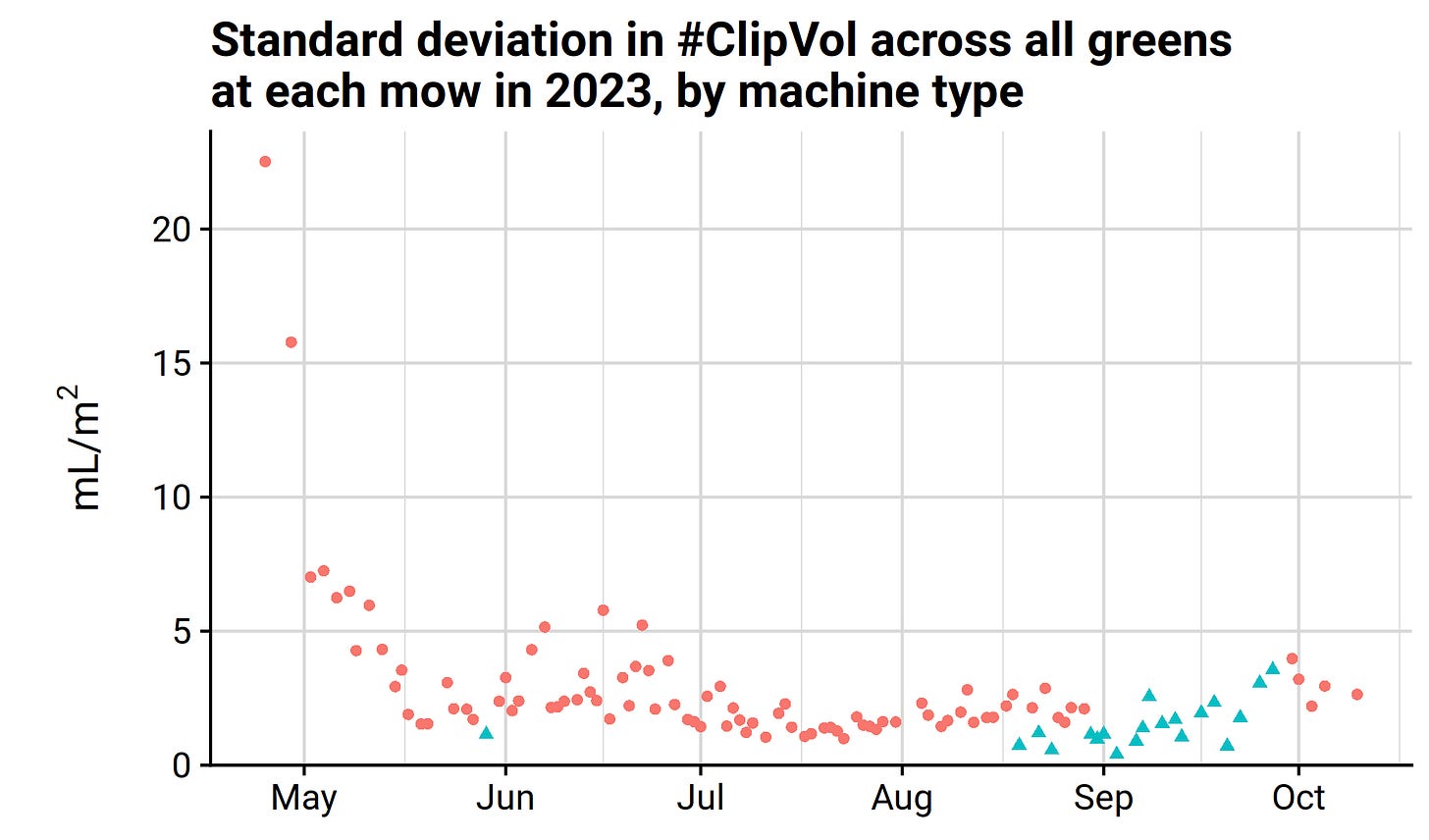Walker vs tri-plex
And a discussion that will be worth your time
Before I get to the main topic, I’d like to promote tomorrow's Micah’s Woods Office Hours Podcast episode, which will be recorded at 0500 CST.
https://www.youtube.com/live/Q1AX13lkU38?si=pS45HD7VCdQ6cUu9
Jason Haines and Bjarni Hannesson will join Micah to discuss the Growth Ratio (GR). In my recent talks, I’ve discussed our use of the GR here at Hazeltine. Jason came up with the GR, and he and Bjarni have been using GR to manage their turf.
It’ll be an early wake-up call if you’re in the States, but I assure you it’ll be worth it.
There seems to be some weird negativity over the use of tri-plex mowers. Much like the angst over pushcarts rolling across greens, the negativity towards tri-plexes comes not from the turfgrass community but from a subset of golfers who populate social media channels.
The tri-plex—or triple, for my international readers—mower has long been an efficient tool; in short, it allows one person to do the work of three. Somewhere along the line—right or wrong—it also became a flag for “muni” or less than top-end golf. I suspect much of this comes from the visual of wide triplex stripes vs narrow walk mower stripes. I often get the question of using triplex mowers: “What do your members say about the stripes?” Well, we don’t have stripes on our greens. More nitrogen means more visible stripes; if you’ve followed along, you know we don’t use much nitrogen.
There probably was a time when triple-mowing putting surfaces produced lesser quality than walk/pedestrian mowing, but today’s triples are leagues ahead of what they used to be. I will argue that the days of a tri-plex being “muni” are gone and that today’s triple mowers have surpassed the quality of walk mowers.
At this point, I was preparing to tell you triple mowers produced a more consistent cut than pedestrian mowers. Then I thought: “I have the data. I'd better check this to make sure.” I pulled some data from the 2023 season, put it in an Excel sheet, and started making charts. I quickly realized my statistical knowledge was insufficient for proper analysis, so I sent a WhatsApp message to my pal, Micah Woods. The charts and quotes you see below are from Micah.
Chart 1 shows the mean #clipvol across all greens for each mow in 2023 by machine type. It’s a nice chart, but even my feeble stats knowledge told me this wouldn’t tell the story. Right from the start, I figured standard deviation would be the way to start.
Micah said:
“The standard deviation [chart 2] would be, on average, how much different from the day’s average would you expect the clipvol to be if you went to a random green on that day and checked it. That was 2.95 on average for walk mow, and 1.5 on average for triplex.
“But I encourage you not to think of that as a meaningful difference that proves triplex is more consistent. You'll see on the charts it doesn't appear to be much better.
“The sd tends to scale with the mean. The coefficient of variation (cv) is an easy way to normalize this across varying means. [chart 3] The cv avg was .28 for pedestrian, 0.29 for triplex, thus, the same.
“The cv can be thought of as the percentage change in clipvol that you'd see on average by going to a green at random and comparing its clipvol to the day's average.
“This is nothing against triplex quality. And there can be other reasons to be happy with or to advocate use of triplex mowers. But your data don't seem to prove a triplex advantage in clipvol consistency.”
So there you go; you can’t argue with the data. Triple mowers are not more consistent than pedestrians, but this data proves another point. They are equally as consistent as walkers, which is probably just as important to know. Now we’re back to efficiency. If a triplex can allow one person to do the work of three, and the quality is not diminished, then there should be no reason not to use them.





Very informative! Thank you!
That's a good point about stripes. Although they might look pretty, does the grass really need to grow that much? I'm reminded of this from David Bataller, in which he talks about not being able to see mowing stripes as a key to green speed and as a key to minimize organic/thatch production on greens: https://youtube.com/clip/UgkxFK1R48aKoRjro45MZivDMVz1djo09F35?si=oBhgO_15G-mOoM1d